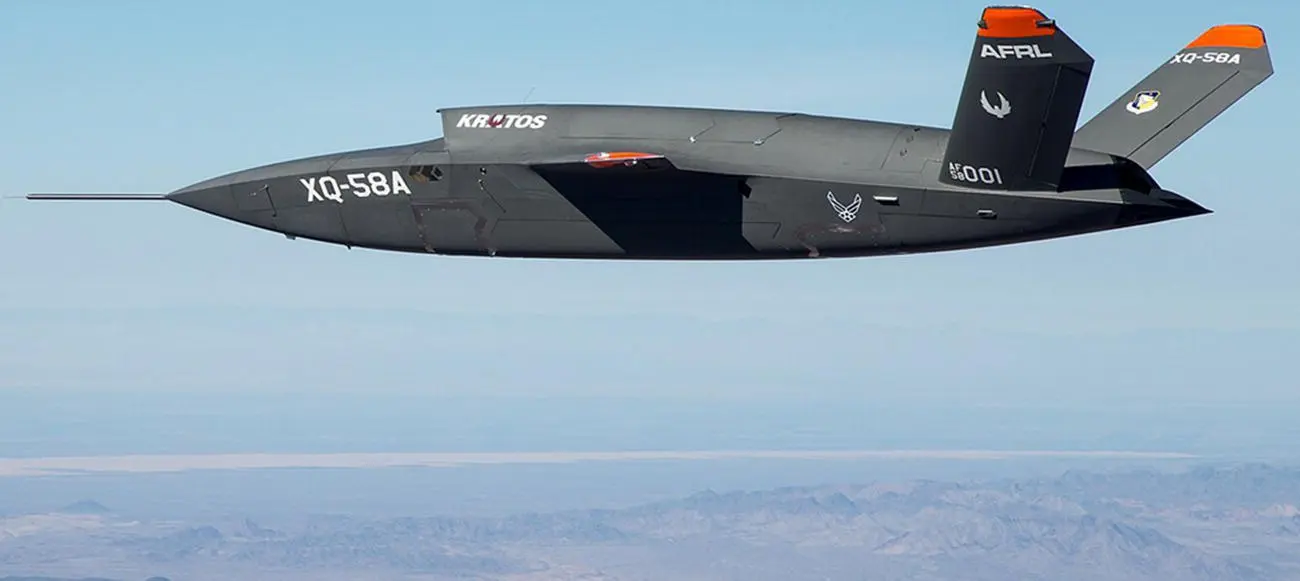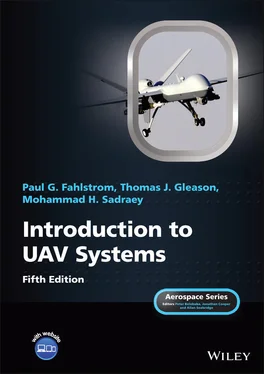There are both land‐ and air‐based missions in both the military and civilian worlds. A land‐based operational base may be fixed or may need to be transportable. If it is transportable, the level of mobility may vary from being able to be carried in a backpack to something that can be packed up and shipped in large trucks or on a train and then reassembled at a new site over a period of days or even of weeks. Each of these levels affects the tradeoffs between various approaches to AV size, launch, and recovery methods, and almost every other part of the system design.
Ship‐based operations almost always add upper limits to AV size. If the ship is an aircraft carrier, the size restrictions are not too limiting, but may include a requirement to be able to remove or fold the long, thin wings that, as we will see later, are typical of long‐endurance aircraft.
Associated with the military reconnaissance mission is target or artillery spotting. After a particular target is found, it can be fired upon while being designated with a laser to help guide a precision‐guided munition. For conventional (unguided) artillery, the fire can be adjusted so that each succeeding round will come closer to, or hit, the target. Accurate artillery, naval gunfire, and close air support can be accomplished using UAVs in this manner. All of these missions can be conducted with the reconnaissance and surveillance payloads, except that a laser designator feature must be added if one is to control precision‐guided munitions. This added feature raises the cost of the payload significantly.
An important mission in the military and intelligence area is Electronic Warfare (EW). Listening to an enemy transmission (communication or radar) and then either jamming it or analyzing its transmission characteristics falls under the category of EW.
Although developing and flight testing a number of experimental combat UAVs such as X‐58 in the past 10 years, UCAVs are still not operational. As the latest development, in 2021, Singapore‐based Kelley Aerospace [3] has developed and flight‐tested the first supersonic UCAV, called Arrow. The plan is to reach speeds up to Mach 2.1.
In 2020, the Air Force awarded [3] contracts to Kratos, Boeing, Northrop Grumman, General Atomics, and Voly Defense Solutions authorizing the companies to compete for the Skyborg project, an effort to field an unmanned wingman cheap enough to sustain losses in combat but capable of supporting manned fighters in hostile environments.
The XQ‐58 Valkyrie ( Figure 2.1), with a wing span of 22 ft and stealth features, has 8 hardpoints (2 weapon bays with 4 in each) with a capacity of up to 550 lb (250 kg) bombs. The UCAV has a maximum speed of Mach 0.85, a range of 2,449 miles, and a service ceiling of 45,000 ft. The XQ‐58 was designed to act as a “loyal wingman” that is controlled by a manned aircraft (a team of manned–unmanned aircraft) to accomplish tasks such as scouting and attracting enemy fire, if attacked.

Figure 2.1 The Kratos XQ‐58 Valkyrie
(Source: 88 Air Base Wing Public Affairs / Wikimedia Commons / Public Domain)
To summarize, the intelligence/surveillance/reconnaissance mission accounts for most of the UAV activity to date, and its sensors and data‐links are the focus of much of today’s development. Target spotting follows closely, with EW third. However, in terms of visibility and criticality, weapon delivery has become the most highly watched application and is a major focus of future development. Other missions will come into their own in time, with their way paved by success in the applications and missions now being actively carried out.
A set of definitions that has become pervasive in the UAV community stems from an attempt to define a hierarchy of UAV requirements in each of the US services. The levels in these hierarchies were called “tiers” and terms such as “tier II” are often used to classify a particular UAV or to describe a whole class of UAVs.
The tiers are different in each US service, which can lead to some confusion. These tiers are tabulated with brief descriptions in Tables 2.2through 2.4for US Air Force, Marine Corps, and Army respectively.
Table 2.2 US Air Force tiers
| No. |
Tier |
Mission/Group |
Example |
| 1 |
N/A |
Small/micro‐UAV |
|
| 2 |
I |
Low altitude, long endurance |
|
| 3 |
II |
Medium altitude, long endurance (MALE) |
MQ‐1 Predator |
| 4 |
II+ |
High altitude, long endurance (HALE) conventional UAV. Altitude: 60,000–65,000 ft (19,800 miles), less than 300 knots (560 km/h) airspeed, 3,000 nautical‐miles (6,000 km) radius, 24 h time‐on‐station capability. Tier II is complementary to the Tier III aircraft. |
RQ‐4 Global Hawk |
| 5 |
III− |
HALE low‐observable (LO) UAV. Same as the Tier II+ aircraft with the addition of LO. |
RQ‐3 DarkStar |
Table 2.3Marine Corps tiers
| No. |
Tier |
Mission/Group |
Example |
| 1 |
N/A |
Micro‐UAV |
Wasp |
| 2 |
Tier I |
Mini‐UAV |
Dragon Eye |
| 3 |
Tier II |
Small |
RQ‐2 Pioneer |
| 4 |
Tier III |
Medium |
Shadow |
Table 2.4 Army tiers
| No. |
Tier |
Mission/Group |
Example |
| 1 |
Tier I |
Small UAV |
RQ‐11A/B Raven |
| 2 |
Tier II |
Short‐Range Tactical UAV |
Role filled by the RQ‐7A/B Shadow 200 |
| 3 |
Tier III |
Medium‐Range Tactical UAV |
|
The most recent classification of systems in use in the United States is related to missions although the old Tier system is still in existence. Eighteen missions relate to four general classes of UAVs – small, tactical, theater, and combat. It is quite specific to US military requirements and is not presented in this book.
2.3 Examples of UAVs by Size Group
We attempt here to provide a broad survey of the many types of UAVs that have been or are being designed, tested, and fielded throughout the world. The intent of this survey is to introduce those who are new to the UAV world to the wide variety of systems that have appeared over the few decades since the revival of interest in UAVs began in the 1980s.
There are a variety of guides to UAVs available and a great deal of information is posted on the Internet. We use The Concise Global Industry Guide [6] as a source for quantitative characteristics of current UAVs and a variety of open‐source postings and our own personal files for information on systems no longer in production.
As a general organizing principle, we will start with the smallest UAVs and proceed to some that are the size of a corporate jet. The initial efforts on UAVs in the 1980s concentrated on AVs that had typical dimensions of 2 or 3 m (6.6–9.8 ft), partly driven by the need to carry sensors and electronics that at that time had not reached the advanced state of miniaturization that has since become possible. In more recent years, there has been a growing interest in extending the size range of UAVs down to insect‐sized devices at one extreme and up to medium air transport sizes at the other end.
Some of the motivation for smaller UAVs is to make them man portable so that a soldier or a border guard can carry, launch, and control a model‐airplane‐sized UAV that allows him or her to take a look over the next hill or behind the buildings that are in front of him or her. Further miniaturization, to the size of a small bird or even an insect, is intended to allow a UAV to fly inside a building or perch unnoticed on a window sill or roof gutter and provide a look inside the building or into a narrow street.
Читать дальше













